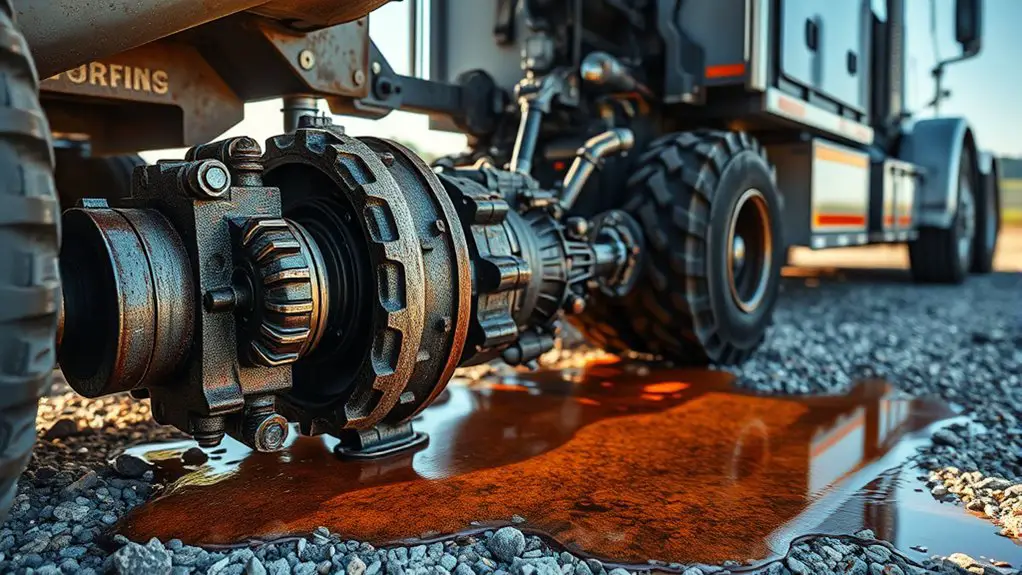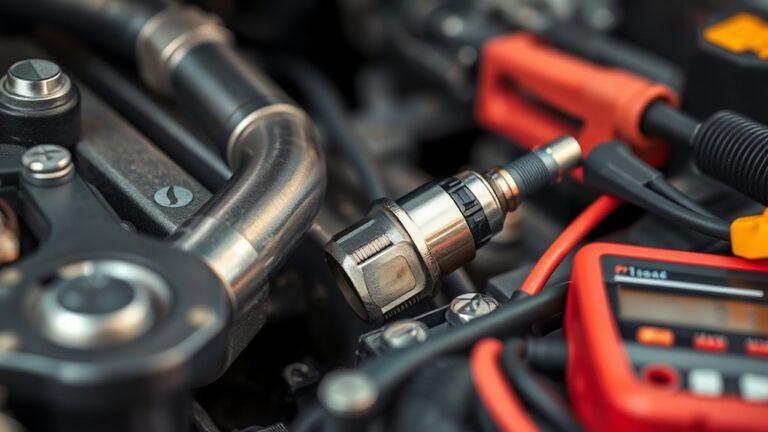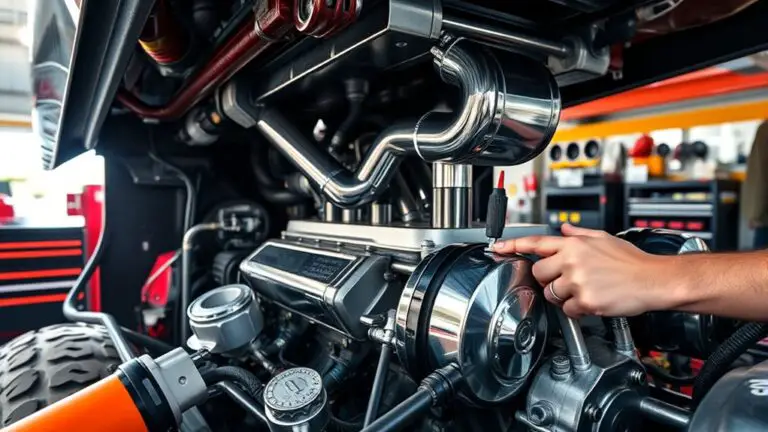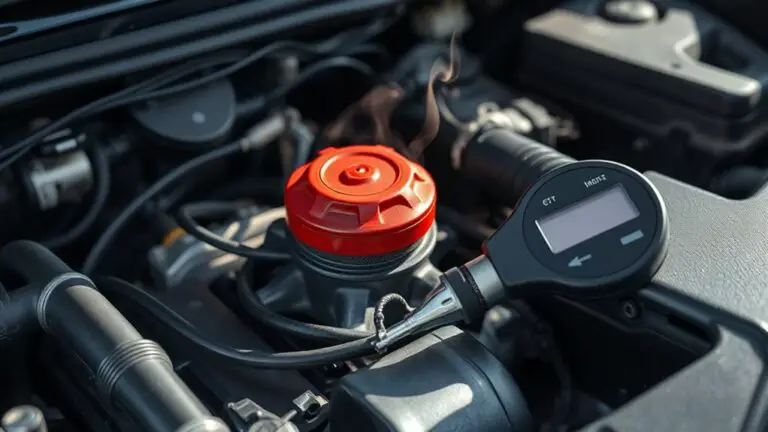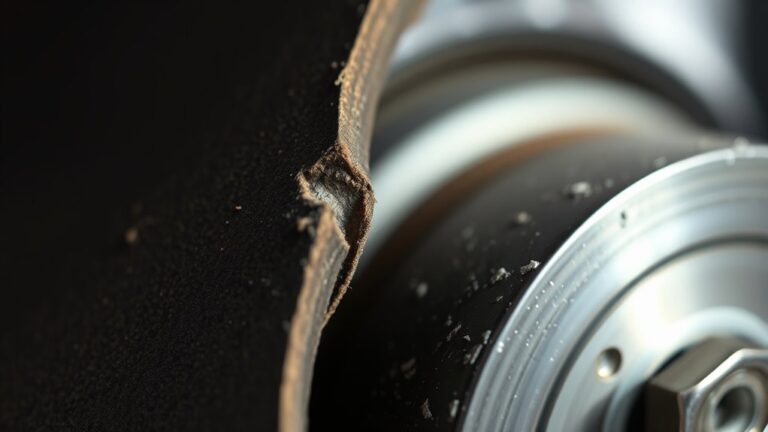How Towing and Load Affect Differential Fluid and Cause Transaxle Problems
Towing heavy loads considerably increases stress on your vehicle’s differential, generating excessive heat and friction that can contaminate differential fluid. This contamination reduces the fluid’s lubricating properties, leading to accelerated wear on the transaxle. If left unchecked, it can result in severe mechanical issues, including difficulties in gear shifting and increased overheating. Recognizing these changes early is essential to maintaining drivetrain health, and there’s more to understand about proactive maintenance practices.
Understanding Differential Fluid and Its Importance
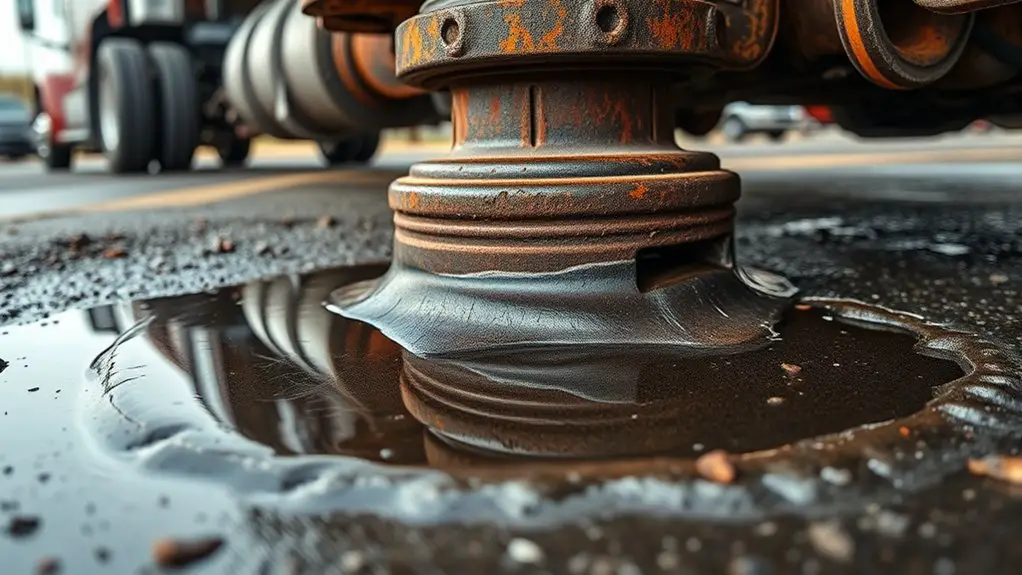
Although you might not think about it often, differential fluid plays an important role in the performance and longevity of your vehicle’s drivetrain. Proper differential maintenance guarantees that the fluid types used are compatible with your vehicle’s specifications. This fluid lubricates the gears, reducing friction and heat buildup during operation, especially under load or towing conditions.
Using the right fluid type is vital, as different formulations—such as synthetic versus conventional—offer varying levels of protection and performance. Over time, the fluid can become contaminated and lose its effectiveness, leading to potential gear wear or failure. Regularly checking and replacing the differential fluid helps maintain peak performance. This not only extends the lifespan of the differential but also enhances your vehicle’s overall efficiency. By prioritizing differential maintenance, you can enjoy the freedom of reliable driving, ensuring that your vehicle can handle the demands of towing and heavy loads without compromising its integrity.
The Role of the Transaxle in Vehicle Performance
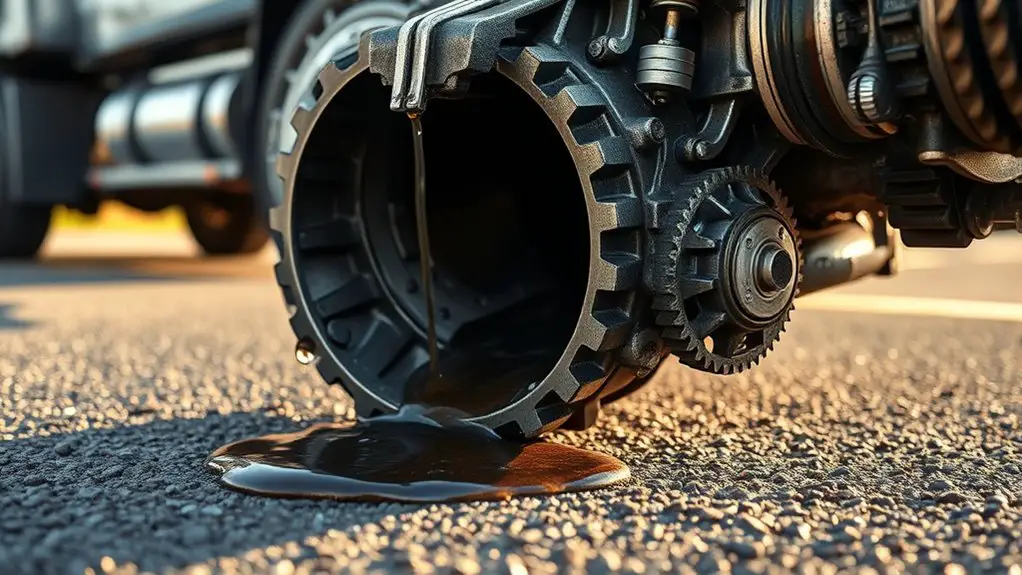
The transaxle plays a critical role in your vehicle’s performance by integrating the transmission and axle into one unit, which optimizes space and weight. Its functionality directly influences vehicle dynamics, affecting acceleration, handling, and load distribution. Understanding how the transaxle operates can help you assess its impact on towing capacity and overall driving experience.
Transaxle Functionality Explained
Understanding how the transaxle operates is vital for grasping its impact on vehicle performance. The transaxle combines the functions of the transmission and the differential, providing efficient power delivery to the wheels. There are various transaxle types, including automatic and manual, each designed for specific driving conditions. Maintaining your transaxle is important; regular fluid checks and changes can prevent overheating and wear. When towing or carrying heavy loads, the transaxle endures increased stress, which can lead to premature failure if maintenance is neglected. Recognizing these dynamics allows you to make informed decisions about your vehicle’s capabilities and the necessary upkeep for maximum performance. Prioritizing transaxle maintenance guarantees longevity and enhances your driving experience.
Impact on Vehicle Dynamics
As you navigate different driving conditions, the transaxle plays an important role in influencing vehicle dynamics and overall performance. It directly impacts vehicle stability, especially under various loads and towing dynamics. A well-functioning transaxle guarantees peak power distribution to the wheels, enhancing traction and control. When towing, the added weight shifts the vehicle’s center of gravity, which can affect handling and stability. If the transaxle struggles with excessive load or fluid degradation, it may lead to performance issues, including increased wear and potential failure. Understanding how the transaxle interacts with other systems is vital for maintaining vehicle integrity and guaranteeing a smooth driving experience, particularly when you’re seeking freedom on the road.
How Towing Capacity Is Determined

To understand how towing capacity is determined, you need to examine vehicle specifications and ratings closely. Factors like weight distribution and the type and size of the trailer also play critical roles in establishing safe towing limits. Each element contributes to the overall performance and stability of the vehicle while towing.
Vehicle Specifications and Ratings
When determining a vehicle’s towing capacity, several specifications and ratings come into play, reflecting the manufacturer’s assessments and engineering standards. You’ll find that vehicle ratings encompass factors such as engine power, transmission type, axle strength, and braking systems. These specifications are essential; they guarantee your vehicle can handle the load without compromising safety or performance. The importance of these specifications cannot be overstated, as they directly influence your vehicle’s reliability when towing. Understanding these ratings helps you choose the right vehicle for your needs, allowing you to enjoy the freedom of towing with confidence. Always refer to your vehicle’s manual for the most accurate and manufacturer-approved ratings, making sure you’re well-informed before hitting the road.
Weight Distribution Considerations
Understanding weight distribution is essential for accurately determining towing capacity, since improper weight management can greatly affect a vehicle’s performance and safety. Proper weight distribution guarantees that your vehicle remains stable and maintains control while towing. Here are three key factors to take into account:
- Load Placement: Distributing the load evenly across the trailer’s axles prevents excessive tongue weight, which can lead to swaying.
- Vehicle Configuration: The height and design of your vehicle influence how weight is distributed; a lower center of gravity enhances towing safety.
- Weight Limits: Always adhere to your vehicle’s towing capacity, factoring in both the trailer and cargo weight to prevent overloading.
Trailer Type and Size
Selecting the right trailer type and size is essential for determining your vehicle’s towing capacity. Each trailer type—be it a utility, enclosed, or specialty trailer—has a specific trailer weight that impacts how much load your vehicle can safely tow. The gross trailer weight (GTW) includes the weight of the trailer itself plus any cargo inside. To guarantee ideal performance and safety, you must align this with your vehicle’s towing capacity, which is specified by the manufacturer. Exceeding this capacity can lead to increased strain on your transmission and differential, resulting in potential failures. Understanding the interplay between trailer type, size, and your vehicle’s towing capacity empowers you to make informed decisions that enhance your towing experience without compromising safety.
Impact of Overloading on Differential Fluid
Although overloading a vehicle may seem like a minor issue, it greatly impacts the differential fluid’s performance and longevity. When you exceed the recommended weight limit, several adverse effects can occur:
- Differential Overheating: Excess weight generates more friction and heat, leading to elevated temperatures in the differential. This can degrade the fluid’s ability to lubricate effectively.
- Fluid Contamination: Increased stress from overloading can cause metal particles to wear off, contaminating the fluid. Contaminated fluid loses its lubricating properties, raising the risk of differential damage.
- Reduced Fluid Longevity: The combination of overheating and contamination accelerates the breakdown of the differential fluid, requiring more frequent changes and potentially leading to costly repairs.
Understanding these impacts helps you make informed decisions about towing and load limits, preserving your vehicle’s performance and extending the life of your differential system.
Signs of Differential Fluid Breakdown
When you notice unusual sounds or vibrations while driving, it could be a sign that your differential fluid is breaking down. These breakdown signs often manifest as grinding, whining, or clunking noises, particularly when turning or accelerating. You might also feel a loss of smoothness in your vehicle’s operation, indicating potential lubrication failure.
Another key indicator is the presence of a burnt or burnt-smell fluid, which suggests overheating and oxidation. The color of the differential fluid can also provide clues; if it appears dark or contains particles, it’s likely degraded.
Additionally, if you experience difficulty in gear shifting or notice an increase in heat, these may signal that your differential fluid has lost its effectiveness. Recognizing these signs early can help you avoid more severe transaxle issues down the line, ensuring your vehicle maintains its performance and safety.
Preventative Measures to Protect Your Drivetrain
To guarantee the longevity and efficiency of your drivetrain, regular maintenance is essential. Neglecting this can lead to costly repairs and decreased performance. Here are three key preventative measures to evaluate:
- Regular Fluid Replacement: Change your differential fluid according to your manufacturer’s recommendations. Fresh fluid reduces friction and heat, preventing breakdown and protecting your components.
- Inspect Load Capacity: Always be aware of your vehicle’s towing and load limits. Exceeding these limits can strain your drivetrain, leading to premature wear and potential failure.
- Routine Inspections: Schedule periodic checks of your drivetrain system. Look for signs of leaks, unusual noises, or fluid discoloration, as these can be early indicators of issues.
When to Seek Professional Assistance
As you monitor your vehicle’s performance, knowing when to seek professional assistance becomes vital for maintaining drivetrain integrity. If you consistently tow loads near or exceeding your vehicle’s towing limits, you should consider professional inspections to assess the condition of your differential fluid and transaxle. Signs of trouble, such as unusual noises, vibrations, or a burning smell, are indications that your drivetrain is under stress.
Additionally, if you notice irregular shifting or decreased efficiency, it’s time to consult a technician. Regular maintenance check-ups become essential after heavy towing, as the increased strain can accelerate wear and tear. Don’t wait for warning lights—proactive measures can prevent expensive repairs down the line. Remember, your vehicle’s performance directly affects your freedom on the road; keeping it in peak condition guarantees you can enjoy every journey without worry.
Frequently Asked Questions
Can Differential Fluid Be Changed With Regular Engine Oil?
No, you can’t change differential fluid with regular engine oil. Differential maintenance requires specific lubricants designed for gear operation, ensuring proper viscosity and additives. Regular engine oil lacks the necessary oil compatibility for high-pressure conditions in differentials, potentially leading to wear or failure. Always use the manufacturer-recommended differential fluid to maintain peak performance and longevity of your vehicle’s drivetrain. Prioritizing the right fluid helps prevent costly repairs down the road.
How Often Should I Check My Differential Fluid Levels?
You should check your differential fluid levels at least every 30,000 miles, though some recommend inspecting it more frequently, especially if you tow or carry heavy loads. Regular fluid inspection is essential for differential maintenance, as low or contaminated fluid can lead to serious issues. While it might seem like an inconvenience, staying proactive can save you time and money in the long run, allowing you to enjoy your vehicle’s performance without worry.
What Are the Symptoms of Low Differential Fluid?
If you’re experiencing symptoms of low differential fluid, you might notice unusual noises, such as grinding or whining, especially when turning. You could also feel vibrations while driving, indicating potential transmission issues. In severe cases, you may notice a decrease in handling performance or a burning smell due to overheating. Regularly checking fluid levels is essential to avoid these problems and guarantee your vehicle operates smoothly and efficiently.
Does Driving Style Affect Differential Fluid Longevity?
Yes, your driving habits can greatly affect differential fluid longevity. Aggressive acceleration, frequent hard braking, and sharp turns can lead to increased fluid degradation due to higher operational temperatures and stress on the components. If you typically drive in a performance-oriented manner, the differential fluid may break down faster, necessitating more frequent changes. To maximize the fluid’s lifespan, adopting smoother driving techniques can help maintain ideal performance and prolong the life of your differential system.
Can Weather Conditions Impact Differential Fluid Performance?
Yes, weather conditions can considerably impact differential fluid performance. Picture a sweltering summer day where temperature extremes force your vehicle’s differential fluid to thin out, reducing its protective qualities. Conversely, in frigid winters, the fluid may thicken, hindering flow and efficiency. High humidity levels can also introduce moisture into the fluid, leading to contamination and potential corrosion. Understanding these factors lets you maintain ideal performance and freedom on the road, no matter the weather.

